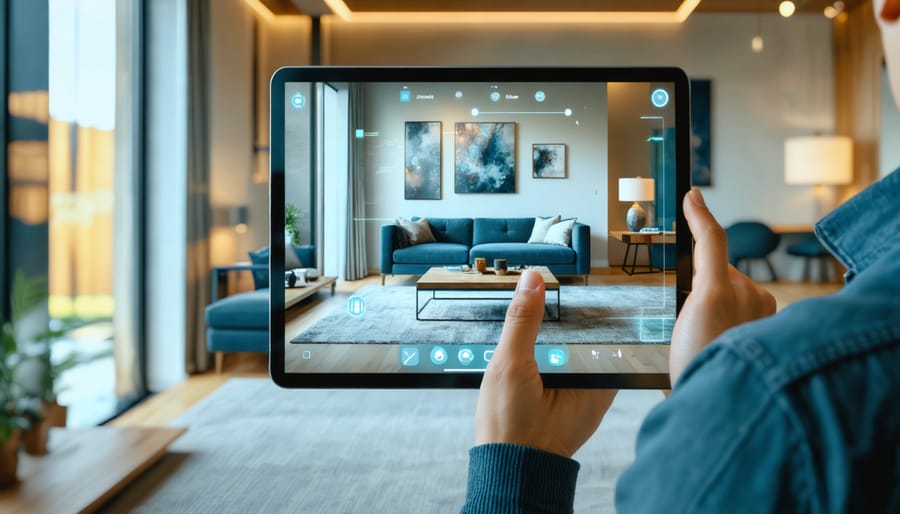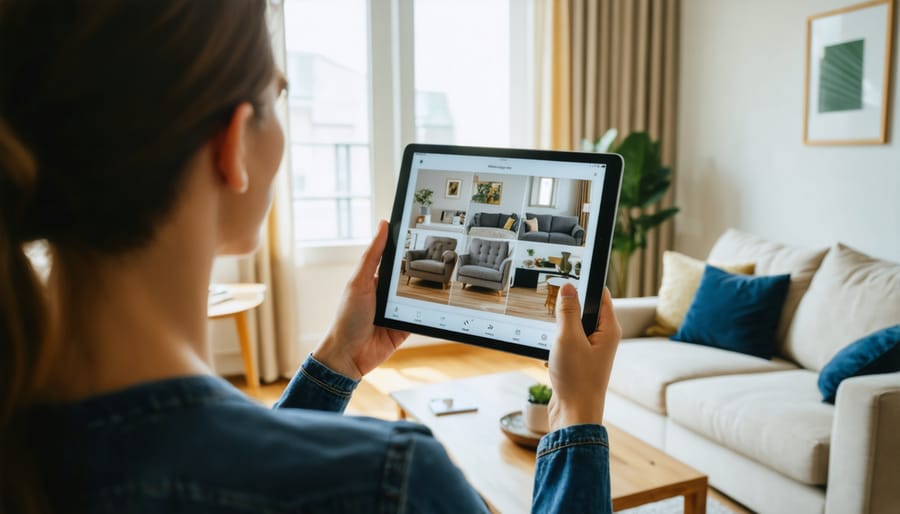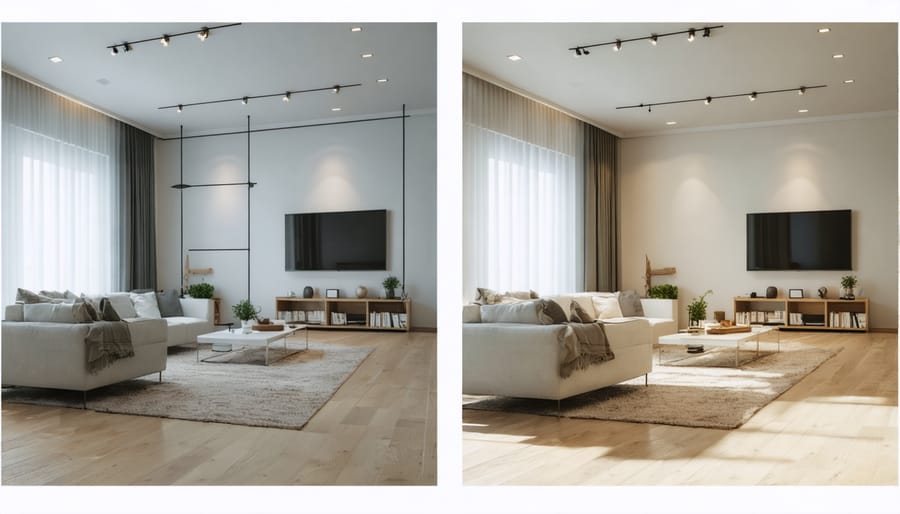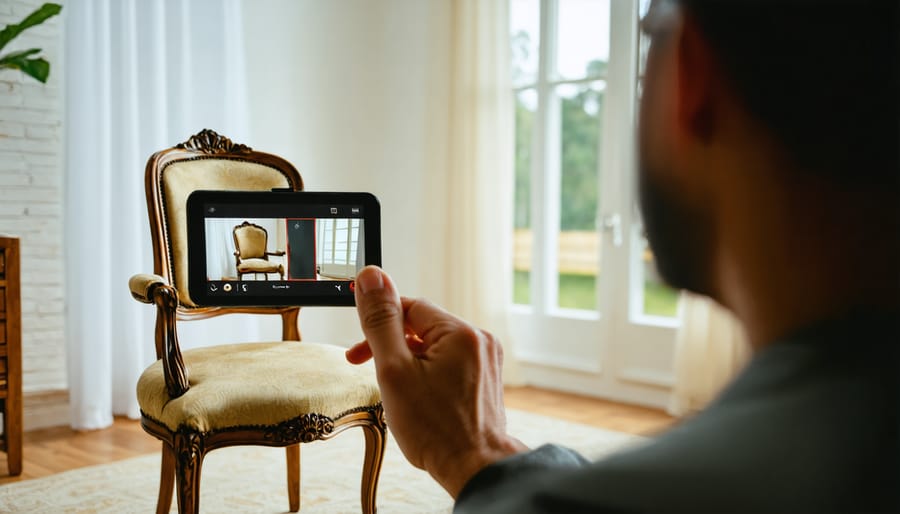
Imagine walking into your living room and seeing virtual furniture perfectly placed before making a purchase, or stepping into a manufacturing facility where workers access real-time equipment data through smart glasses. This isn’t science fiction—it’s the current reality of Augmented Reality (AR) technology, and it’s revolutionizing how we interact with the world around us.
As global tech giants pour billions into AR development and mainstream adoption accelerates, we’re witnessing a fundamental shift in how businesses operate and consumers make decisions. From retail and healthcare to education and industrial applications, AR is proving to be more than just a novel technology—it’s becoming an essential tool for future-forward operations.
Recent market projections suggest the AR industry will reach $97.76 billion by 2028, but the true value lies in how it’s already transforming everyday experiences. Through the seamless blend of digital information with our physical world, AR is creating opportunities that were previously impossible, making it not just a future possibility, but an emerging reality that’s actively shaping our present.
Virtual furniture placement through augmented reality has revolutionized how we plan and design our living spaces. Instead of relying on imagination or traditional measuring tape, homeowners can now use their smartphones or tablets to visualize exactly how furniture pieces will look in their rooms before making a purchase.
Leading retailers have embraced this technology, offering AR apps that allow customers to place virtual replicas of their furniture catalog directly into real spaces. By simply pointing their device’s camera at the intended area, users can see true-to-scale 3D models of sofas, tables, chairs, and other pieces in their actual environment. The furniture can be moved, rotated, and even viewed from different angles, providing a realistic preview of how the piece will fit and look in the space.
This technology eliminates much of the guesswork in furniture shopping, reducing the likelihood of returns and ensuring customer satisfaction. Property managers particularly benefit from this tool when planning office layouts or staging properties, while interior designers can quickly show clients multiple options without physically moving heavy furniture pieces around.
The accuracy of AR placement has improved significantly, with many apps now able to detect floor surfaces, walls, and lighting conditions to create ultra-realistic visualizations.

Augmented reality is revolutionizing how we measure and plan spaces with unprecedented accuracy. By overlaying digital information onto the physical world, AR apps can instantly capture room dimensions, calculate square footage, and identify potential obstacles with millimeter precision. This technology eliminates the need for manual measurements and reduces costly errors in renovation projects.
Through smart space planning features, AR enables users to visualize furniture placement, test different layouts, and optimize room flow before making any physical changes. Property managers and designers can create virtual walkthroughs, helping clients understand spatial relationships and make informed decisions about furniture restoration and placement.
The technology’s measurement capabilities extend beyond basic dimensions. AR can analyze wall angles, detect surface irregularities, and even assess lighting conditions to ensure optimal furniture positioning. This level of detail helps homeowners and professionals alike avoid costly mistakes and achieve perfect fits for restored pieces, making it an invaluable tool for modern interior planning and renovation projects.

Augmented reality is revolutionizing the way we plan and execute furniture placement and interior design, significantly reducing costly mistakes that have traditionally plagued homeowners and designers alike. By overlaying virtual furniture in real spaces, AR apps allow users to visualize exact dimensions, colors, and styles before making any purchases or moving heavy pieces.
Consider the common scenario of ordering a sofa only to discover it doesn’t fit through the doorway or overwhelms the living room. AR technology eliminates these expensive mishaps by providing precise spatial awareness and measurements. Users can virtually walk around furniture pieces, check clearance spaces, and ensure proper flow between rooms – all before spending a single dollar.
The technology also prevents design errors by allowing experimentation with different color schemes, textures, and arrangements in real-time. Instead of relying on imagination or rough sketches, property managers and homeowners can make informed decisions based on accurate visual representations. This capability has shown to reduce return rates by up to 40% in furniture retail and cut down on costly remodeling corrections.
For commercial spaces, AR helps avoid disruptions to business operations by enabling precise planning of office layouts and furniture installations. Property managers can visualize different configurations without physically moving items, saving both time and potential damage to expensive furniture pieces. The result is more efficient project execution and significant cost savings in both materials and labor.
Augmented reality is revolutionizing how clients and professionals streamline design decisions in real-time. Instead of relying on imagination or static samples, AR technology allows customers to instantly visualize furniture pieces, colors, and finishes in their actual space before making final choices.
This visualization capability significantly reduces decision-making time and increases confidence in selections. Homeowners can now see how a restored antique chair would look in their living room, or property managers can evaluate how different furniture arrangements impact their commercial spaces. The technology eliminates the guesswork traditionally associated with furniture selection and restoration projects.
AR applications also enable immediate collaboration between clients and craftsmen. When discussing restoration options, professionals can show clients multiple finish options or repair techniques overlaid on their actual furniture piece. This interactive approach helps clients understand the potential outcomes of different restoration choices, leading to more informed decisions and higher satisfaction with final results.
The technology has proven particularly valuable for remote consultations, allowing clients to receive expert guidance without scheduling in-person visits. This efficiency not only saves time but also reduces the likelihood of miscommunication or costly revisions, making the entire restoration process more streamlined and customer-friendly.
Augmented reality is revolutionizing how restoration professionals showcase their work to clients before a project begins. Using AR applications on smartphones or tablets, customers can now see exactly how their restored furniture will look in their space. This technology overlays a digital rendering of the restored piece onto a real-time view of the room, allowing clients to visualize the final result from different angles and in varying lighting conditions.
The benefits of this pre-visualization approach are significant. Clients gain confidence in their restoration decisions, knowing precisely how the finished piece will complement their existing décor. For instance, a client considering whether to restore an antique armchair can see how different fabric choices and finish options would look in their living room before committing to the restoration process.
This technology also helps reduce revision requests and customer dissatisfaction, as expectations are clearly set from the beginning. Property managers particularly benefit from this tool when planning large-scale restoration projects, as they can present virtual mock-ups to stakeholders and get immediate feedback on proposed restorations.

Augmented reality is revolutionizing how we plan spaces for restored furniture pieces. Instead of relying on tape measures and rough estimations, property owners can now use AR apps to visualize exactly how restored pieces will fit in their intended locations. This technology allows users to create virtual representations of furniture items and place them in real spaces through their smartphone or tablet cameras.
The benefits are particularly valuable when dealing with antique or custom-restored pieces. Rather than risking damage from multiple attempts at positioning heavy furniture, users can experiment with different placements virtually. This technology helps prevent costly mistakes and ensures that restored pieces not only fit physically but also complement the existing space aesthetically.
Commercial property managers find this especially useful when planning large-scale restoration projects. They can demonstrate to clients exactly how restored furniture pieces will look in various configurations before finalizing decisions. The technology even accounts for lighting conditions and shadow effects, providing a remarkably accurate preview of the final result.
For homeowners undertaking restoration projects, AR tools offer peace of mind by confirming that their investment will work perfectly in their space, eliminating guesswork and potential disappointment.
As we’ve explored throughout this article, augmented reality is revolutionizing the way we approach interior planning and design. The technology has proven itself to be more than just a novelty, offering practical solutions that help you transform your living space with confidence and precision.
The future of AR in interior planning looks exceptionally promising. As the technology continues to evolve, we can expect even more sophisticated applications that will make design decisions easier and more accurate. From precise furniture placement to instant visualization of restoration projects, AR is becoming an indispensable tool for homeowners and professionals alike.
The adoption of AR technology is already showing significant benefits: reduced decision-making time, fewer costly mistakes, and increased customer satisfaction. Property managers are finding value in virtual staging capabilities, while restoration professionals use AR to provide more accurate quotes and project previews.
Looking ahead, we can anticipate AR becoming a standard feature in interior planning, with more user-friendly applications and seamless integration with existing design tools. The technology’s ability to bridge the gap between imagination and reality makes it an invaluable asset for anyone involved in interior design and furniture restoration.
For those considering whether to embrace AR technology, the evidence is clear: it’s not just the future – it’s the present, and its role will only continue to grow in importance.